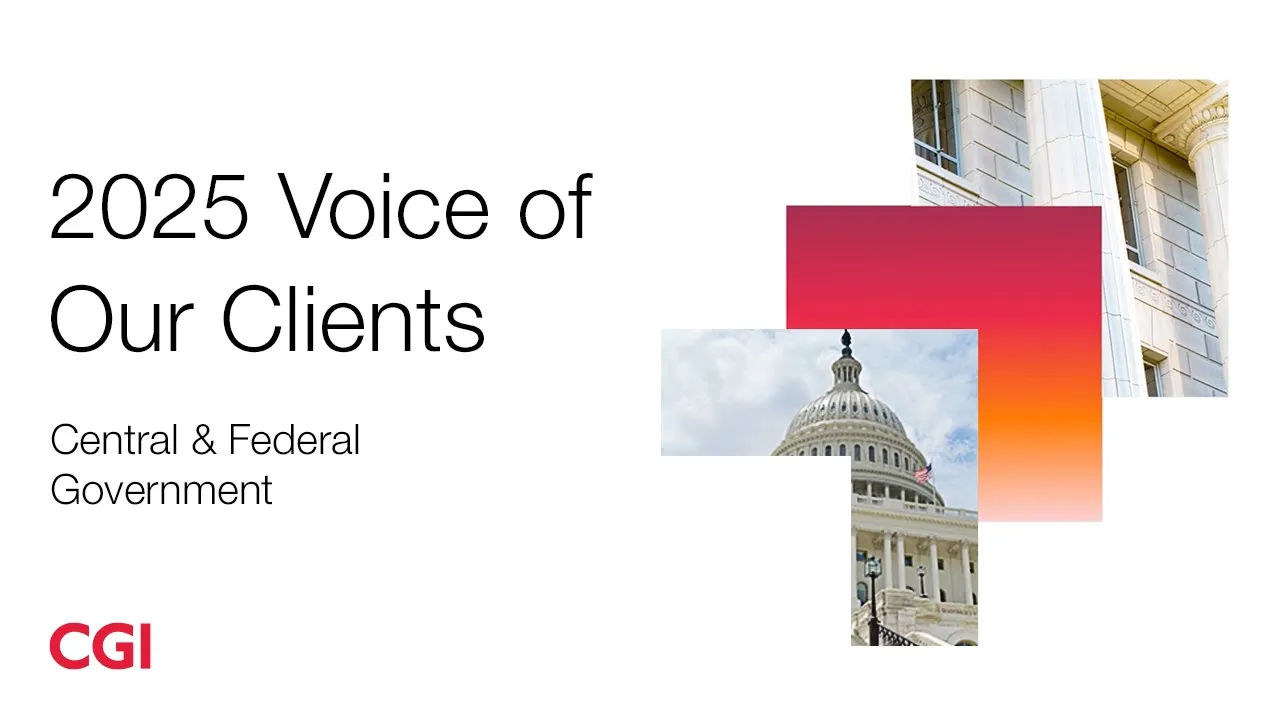How do central and federal government organizations address rising citizen expectations for digital services, complex policy demands and budget constraints? In this video, we explore insights from the 2025 CGI Voice of Our Clients research, based on in-depth interviews with 266 central and federal government executives on the priorities and challenges shaping transformation to drive efficiencies and taxpayer value.
From piloting AI projects and securing aging systems to addressing critical talent shortages and strengthening cybersecurity, central and federal government leaders are being called on to modernize rapidly and responsibly.
Key trends covered in this video:
- Digital acceleration and legacy modernization
- Political, fiscal and regulatory shifts
- Persistent talent shortages
- Cybersecurity as a core priority
- AI adoption and data readiness
Learn from real-world examples that highlight how government leaders are using AI and accelerating digital transformation to address talent shortages, improve citizen trust and deliver mission results.
At CGI, we partner with government leaders on their digitization initiatives by targeting quick wins focused on achieving outcomes.
Video transcript
- Addressing rising citizen demands through modernization
-
Rising citizen expectations for digital services, complex policy demands and budget constraints are intensifying the need to adapt quickly. From piloting AI projects and securing aging systems to addressing critical talent shortages and strengthening cybersecurity. Central and federal leaders are being called on to modernize rapidly and responsibly.
This transformation goes beyond just keeping up with technology. It’s about building public trust, improving citizen experiences, and delivering mission outcomes, all while driving operational efficiencies.
Citizens increasingly demand digital first services that are fast, reliable and secure, so modernization, really, is key to governments keeping up and staying relevant.
Our Voice of Our Clients research with 266 government leaders underscores the importance of proactive, future-ready strategies that can endure political change, regulatory complexity, and evolving cybersecurity needs.
- Top trends reshaping central and federal government
-
Insights from the research highlight three key trends shaping the priorities of central and federal government leaders.
Technology and digital acceleration rank as the top macro trend, with more than 70% of executives citing it as having the greatest impact. Leaders are focusing on modernizing and retiring legacy applications to improve service delivery, strengthen security, and scale more effectively.
About the same number of leaders say that shifting political, fiscal, and regulatory dynamics is significant, and a key factor in decision-making. Shifting policies and budget constraints often delay or reshape projects, reinforcing the need for flexible governance.
Talent shortages persist. Nearly half of executives see demographic trends, including an aging workforce, as barriers to attracting and retaining staff, especially those with specialized skills. While upskilling and external partnerships provide support, competition with the private sector slows their progress.
Central and federal organizations rate their business model agility at just 5.7 out of 10, underscoring the importance of agile methods, cross-department collaboration, and strong executive sponsorship to address growing citizen expectations.
These trends are heightening the pressure on central and federal agencies to deliver tangible outcomes. The biggest finding is that governments are still struggling with large legacy applications, but they're under so much pressure these days to get things done fast with other competing priorities.
Whether it is a lack of budget or the shift to AI, or all of these other things, agencies need to hire and train for key roles and offer clear growth paths to actually retain them. If possible, they should also use hiring bonuses as an incentive and leverage direct hiring authorities to onboard resources quickly.
- Government client success stories with AI and automation
-
For an agency in North America, we are helping to integrate AI into customer service operations for federal benefits—deploying virtual assistants that help call center staff quickly answer citizen questions, saving time and resources while improving the experience.
We supported a European national crime agency in implementing AI solutions to process international alerts more efficiently, expediting the management and sharing of intelligence. One solution automatically generates daily reports—freeing up dozens of full-time employees to focus on intelligence or case development instead of administrative tasks.
To address talent gaps, another government agency set up a Center of Excellence to identify and develop automation opportunities. CGI is fully integrated into the agency's IT division, providing specialized expertise while supporting technical skills development.
These projects demonstrate how AI and automation are transforming public sector operations, enabling agencies to work smarter and serve citizens better.
- Best practices for piloting AI in government
-
For central and federal government, most of the AI is being done from a pilot perspective. The idea is to do a pilot, whether it's a chatbot or to enhance and turbocharge some automation out there so they can actually quantify success.
Before launching AI Pilots, it is essential to put strong data governance in place. This includes cleansing data by removing errors, duplicates, and irrelevant information and focusing on hiring data scientists and upskilling teams so they can manage and sustain AI initiatives effectively and for the long term.
Make sure you're getting value by evaluating cost savings compared to what's been invested. We've seen agencies reduce cost considerably simply by replatforming their applications to the cloud. And in these cases, success is also measured by improvements to their security posture.
Citizens are more likely to adopt digital services when they feel confident that their data is protected.
- The path forward: Modernization strategies for government leaders
-
Technology, talent, and governance remain central to modernization.
Whether accelerating AI adoption or modernizing and securing legacy systems, central and federal leaders must foster agility and innovation while navigating fiscal constraints and policy shifts to deliver the operational efficiencies being demanded.
By harnessing data-led outcomes and building strategic partnerships, agencies can provide the right technology services to enable a more efficient and effective delivery of government operations and services.
The drivers for change are strong, and the moment for bold, enduring action is now.




